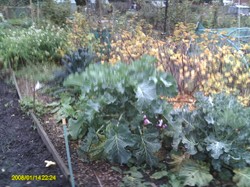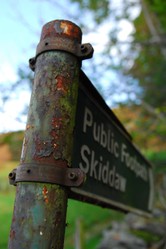The principle of organic cultivation, gardening or farming, is that your priority is to feed the soil. The soil is a living entity, a complex interacting ecosystem that includes millions of micro-organisms, such as worms, bacteria, fungi and algae, all of which provide the basis for plant growth, all of which must be protected if your plants are to grow well. While fertiliser is useful, it cannot replace a healthy soil. To feed the soil there is a variety of substances that you can use.

Caring for your soil
by frankbeswick
Organic principles allow and encourage various ways of adding to your soil's fertility, such as manure and mulch of various kinds.
Organic principles
Suppose that you had a plot of land and wanted to grow vegetables on it. You might add fertiliser, and there would be some benefit, but you would not do as well as you would like, as the fertiliser may well be washed out by rain. You would also notice that the soil was growing paler and it might be more prone to being washed away. What would be happening is that your soil would be low in humus, a black, complex colloid that holds soil together and keeps water and nutrients in the soil. You can always tell a soil rich in humus, it has a rich, dark colour, often black.
Organic philosophy speaks of the living soil. One spoonful of rich, dark soil contains millions of micro-organisms, all of which interact in such a subtle, amazingly complex way, that they maintain the existence of life on earth. Without these millions of fungi, bacteria, algae and animals of various kinds, the soil would wither, become infertile and prone to erosion. Thus in the organic movement we believe that the farmer/ gardener should first and foremost farm the soil, and the rest of the plants that he/she grows follow from this strategy.
At the heart of all soil fertility is humus, a colloid so complex that science has still not figured out all its characteristics. It is the last stage in decay of all organic substances, but it provides a vital service, for it is the glue that holds soil together. Now you can see why fertilser alone is insufficient, if there is no glue to keep it in the soil. Furthermore, humus stores both nutrients and water in its complex molecular structure, so its presence slows water run off from soils that washes away nutrients with it. Some flooding has been exacerbated by the absence of humus from soils as trees have been cut down. The richer your humus content, the better your soil is protected from drought.
organic gardening
 | Organic Gardening Beginner's Manual: The ultimate "Take-You-By-The-Hand" beginner's gardening man... *** #1 Amazon BESTSELLER in Vegetable Gardening *** Here's the ultimate "Take-You-By-The-Hand" beginner's gardening manual for creating and managing your own organic garden. Eve... |
Organic soil improvers
Mulching, which consists of laying ground cover, is a vitally important technique. Strictly speaking even a plastic sheet is mulch, but it is not organic. Organic mulches are naturally occurring substances that enrich or protect the soil. This Autumn [ Fall] I will be laying as rich a layer of leaves as I can around the trees and over some of the beds. This will serve more than one function. It will protect the soil from damage by raindrops and will keep it warmer, but also as the leaves break down by fungal action in the following Spring they will nourish the soil. This will be done by adding some nutrients, but also by improving soil structure, which is maximised by having aprticle sof a variety of shapes and sizes in the soil so that water, air and nutrients can be held more effectively therein. Some growers use leaf mould, which is leaves kept in a container for a year or so to rot down before being applied. This is a useful soil improver, though it is not nutrient rich. Those readers from North West or Northern Europe or New England should be able to get plenty of leaves.That there is some nutrient in leaf mould is shown in this example. Once my spade cut through a potato that I was digging up, so I tossed it aside and it landed in the leaf mould bin. Next year I noticed it growing, and I got a small potato from it, grown only in leaf mould.
Those of us whose ancestors came from the West of Ireland or Scotland might have heard of the use of seaweed as mulch. Our Celtic ancestors knew well the fertilising power of seaweed and often used it to mulch their land. Surprisingly it is not any more salty than terrestial plants are, though the water on it might be salty. Spread over the land it breaks down and leaves its rich nutrient content so enrich your soil
At the moment on my allotment we have a pile of root grindings delivered by the council. These are related to woodchip, and are the product of uprooted tree stumps that have been oput through a grinder. They rot down very easily and enrich the soil. Related to them is woodchip, which the council delivers to our allotment and which can be used to surround fruit trees. This takes longer than root grindings to rot down, but does so in the end, and in doing so provides a useful protection against weeds whilst it lasts and also some nutrients. Bark can be used in the same way.
Soil care
 | Planters Pride RZP3056 8.8-Pound Miracle Mulch Amazing expanding mulch works for many garden projects. |
 | National Bark Sales 106 Montaho Western Red Cedar Mulch, 3 Cubic Feet Montaho western red cedar mulch conserves moisture, retards weed growth, keeps soil workable and insulates surrounding foliage. Versatile, lightweight, clean and rich with natur... |
Soil enrichers
Anything that you add to soil for enrichment is called manure, but normally we restrict the word to dung of various kinds. Manure needs to be allowed to rot down, because new manure is too active and can damage plants that it surrounds. There are various kinds that are used. Cattle manure is very good, but many use horse manure. This though, is often full of weed seeds. Poultry manure is very rich, but should be used sparingly and when mature. It also stinks. Once I had a bag that leaked in the boot of the family car. Daughter was not happy: "I understand, I'm only your daughter; cars are for chicken manure, not daughters, what does a woman count when compared to chicken manure............" This went on for some time.
Another valuable soil enricher is worm compost. Technically speaking this is worm manure, as the worms eat the food and turn into an exceptionally rich soil enhancer. But it should be used sparingly, as it can be too rich if used in excess. Furthermore, the liquid from the compost is drained off through a tap, and is exceptionally rich. It should be applied only when mixed with water through a watering can. Worm compost is made in closed containers, so unlike normal compost it can take cooked food, which in a compost heap would attract rats.
Mushroom compost, which is the residue from mushroom growing, is useful, as it provides calcium. It is often used by cereal farmers. It is especially useful for brassicas, such as cabbage, which require a slightly higher pH than many other plants, and pH rises as calcium levels do.
Composters
 | Worm Factory 360 WF360G Worm Composter, Green " Composting with worms allows you to turn kitchen scraps, paper waste and cardboard into nutrient-rich soil for your plants. The Worm Factory 360 composting system makes the en... |
Compost
Compost is decayed vegetable matter. There are two ways of making it, in a bin or a heap. Sometimes the heaps are freestanding, but many of us use wooden constructions, in my case made out of scrap pallets, which I allow to decay and then replace. A bin is often made of plastic and has a bottom that is open to the soil. I use two kinds of compost. There is the garden compost made out of plant residue, and there is kitchen compost, made out of of kitchen scraps. The plant remains go into the bins made of pallets, whereas the kitchen scraps go into the plastic bin. These are richer in nutrients than the garden compost is.
When a raised bed has been harvested, I refill it with compost from the heap, though sometimes the compost must be bought in if there is insufficient. I use the kitchen compost to lay as a top dressing over the garden soil, and spread it out. A top dressing is an extra layer of nourishment on the soil.
Be aware though, compost is made by heating through the actions of micro-organisms, known as thermophiles, which means heat lovers, so a heat can become very hot. My younger brother, also a gardener, once stuck his hand into a heap to check the temperature. It was about seventy degrees! Mistake. You can sometimes see a compost heap steaming. That compost is produced by heating shows that it needs oxygen to fuel the combustion. To maintain the oxygen level the heap or the bin needs regular turning, which is easier with a heap than a closed bin.
It is important to mix your materials properly. Grass cuttings heat up so quickly that they consume all the oxygen and can leave a smelly, anaerobic mess. You need to mix in some woody material to moderate the temeprature with a certain amount of woody material. Grass contains over much nitrogen for the heap, and there is a need for a heavy carbon content, which comes from the wood, to moderate the rate of combustion. A heap should have a balance of the main elements needed for plant growth:nitrogen, potassium and carbon. So too much green matter means excessive nitrogen and too fast a rate of combustion. A good source of carbon is shredded paper or cardboard.Urine is always a useful contributor to a compost heap. At the famous Heligan Gardens in Edwardian times gardeners were urged not to use a toilet but go to the compost heap to pass water.
A loam pile is composed of turfs turned upside down and left in a heap. After a couple of eyars they turn into rich Earth, so if you are taking up a alwn, do not waste the turfs taken up, make a loam pile.
compost bins
 | Exaco Trading ECO-2000 2.4 Gallon Kitchen Compost Waste Collector Making your own compost starts in the kitchen by collecting all your organic waste and adding it to your outdoor composter. As much as 30% of household waste can be composted an... |
Fertilisers
You can purchase fertilisers anywhere. However, they will always be given an NPK rating: N for Nitrogen, P for Phosphorus, K for Potassium. One of the best is blood, fishmeal and bone, which contains a high range of nutrients. Sometimes bonemeal alone is used, but you should use gloves when handling it, as it might contain viruses. Lime is often used, as it sweetens the soil, which means makes it less acidic. It is always useful for brassicas and for potatoes. A related product is calcified seaweed, which we obtained from the seabed off Cornwall, but the supply is running out.
Yet another product relatively new to the market is rockdust.This began to be added after scientists noticed that British soils were declining in mineral content. It is made from ground granite or basalt. I have added it to my soil and been quite pleased with the results.
Sadly, one useful source of nutrients is bodies. Many allotment holders used to bury cats and dogs in their flower beds. We had a case when my brother's pet hamster died. He was so upset that we gave it a good burial beneath the rose bushes, and next year the roses thrived.
Peat can be used, not for nutrients but for soil structure, but in Britain it is a scarce resource and it should not be mined. We are trying to preserve our peat uplands to aid water retention. Coir, which is derived from coconut fibre is now being used more often.
Tea and coffee waste is a useful soil enhancer. I pour waste tea onto flower beds, as it contains piotassium and the milk contains calcium.
Fertiliser
 | 10 Lbs of Azomite - Organic Trace Mineral Soil Additive Fertilizer - 67 Trace Minerals: Selenium,... A to Z Minerals- A Complete Organic Fertilizer A Source of Minerals & Trace Elements Azomite is the name of a special rock in Utah. Early this century geological prospector Roll... |
 | Nature's Footprint Glacial Rock Dust Soil amendment, 5-Pound Glacial Rock Dust is a soil amendment containing a broad range of trace minerals, many of which have been slowly lost through the ages on commercial farmland, by erosion, leachi... |
Conclusion
These are the main soil enhancers that you can use to enrich your soil. Though you do not need to sue each one, they are all valuable in the garden, and without the sue of at least some of them your soil will not flourish, it will become pale and unproductive.
You might also like
The Reforestation of SkiddawBritain's project of renewing the Atlantic rain forest is taking a further st...
Rewilding the Isle of the ThundergodTaransay is an uninhabited island one mile off the coast of Harris.but there...



 Pilgrimage. A reviewon 06/15/2025
Pilgrimage. A reviewon 06/15/2025
 Leo the Fourteenthon 05/09/2025
Leo the Fourteenthon 05/09/2025
 The Melsonby Hoardon 03/25/2025
The Melsonby Hoardon 03/25/2025



Comments
I think that ground limestone would fall into the category of rock dust. Therefore it would be available in areas where it can be mined and ground.
Thank you for your comment below, in answer to my previous observation and question.
Is ground limestone as precariously available as, more precariously available than, not at all as precariously available as calcified seaweed?
It depends on your soil's pH. Calcified seaweed is a good soil enhancer, but very acidic soils, such as found in certain mountain regions, such as parts of North Wales might require ground limestone, which is a bigger dose of alkalinity than calcified seaweed might provide.
Thank you for your comment below, in answer to my previous observation and question.
Is soil inhabitable by brassicas and potatoes improved by calcified seaweed or is that more lime's -- ;-D -- calling?
We are using it up faster than it is being renewed
The first paragraph to the fifth subheading, Fertilisers, alerts us that " A related product is calcified seaweed, which we obtained from the seabed off Cornwall, but the supply is running out."
Is calcified seaweed going extinct just off Cornwall or worldwide?
Normally we replace mulch every year, but there are no hard and fast rules on this matter.ĺ
No visual considerations should interfere with soil health
Thank you!
Some Unitedstatesians affirm that spring has sprung by replacing mulch --be it looking bad, be it looking good -- each year.
Do you replace mulch every year or would such observations as effectiveness and such visuals as color and depth determine your schedule?
I always prioritised depth of mulch, but avoided putting mulch up against the tree bark.
Let's say that you have a limited amount of mulch available.
On this, western side of the (Atlantic) pond mulch likelier might be applied according to the thickness of the layer that one seeks (typically 3 inches [7.62 centimeters]).
But some, such as myself, always note the distance to the tree drip line (imaginary circle formed by plotting on the ground the end-points of the lowest branch layer's furthest extension outward from the trunk). The latter approach spreads mulch from a dry moat of cleared soil between the tree base and the mulch (typically 1 to 3 inches [2.54 to 7.62 centimeters]).
Which would you prioritize, the attainment of the drip line by, or the thickness of the layer of, mulch?